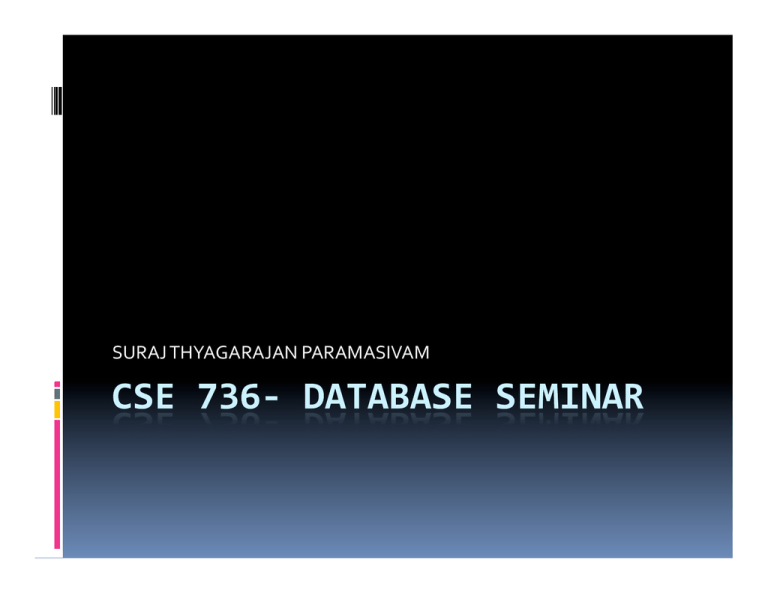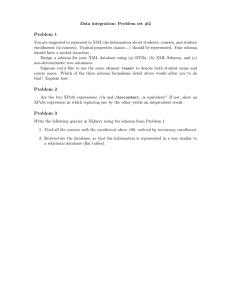Document 10791947
advertisement

SURAJ THYAGARAJAN PARAMASIVAM Data Integration and Genomic Medicine Brenton Louie, Peter Mork, Fernando Martin-­‐ Sanchez, Alon Halevy,Peter Tarczy-­‐ Hornoch Bio2RDF: Towards a mashup to build bioinformatics knowledge systems Francois Belleau, Marc-­‐Alexandre Nolin, Nicole Tourigny, Philippe Rigault, Jean Morissette What is Bioinformatics ??? Why Bioinformatics ??? Internet Descriptive, observational science Hypothesis driven RESEARCH Predictive information Science “Discovery” driven SEARCH If not for Bioinformatics !! Structural Plasticity of the Human Genome (Copy number variants) Individual Human Variation (when a mutation is not a mutation!) Alternate Splicing Non-­‐Coding RNAs (genes?) None of these most important genetic discoveries would have been possible !!! Data Integration.. Why is that important ?? Entrez NCBI GenBan k EMBL • Submissions • Updates CIB DDBJ • Submissions • Updates getentry • Submissions • Updates EBI SRS Common Data Integration Architectures Data Warehouses Fast queries and clean data Stale Data,Complex Schema Database Federation Current Data, Flexible architecture Slower queries, Complex Schema, unclean Data Database federation with mediated schema Current Data, Flexible architecture, schema tailored to users Slower queries, complex schema, unclean data,mapping from source schema to mediated schema required Peer data management systems Current Data,Flexible Architecture,Schema Tailored to users, Mapping between schemas distributed across peers Experimental, slower queries, unclean data Two Dimensions of Data Integration The Integration Axis (Where the data resides) Data and Knowledge Representation Integration Architecture Data Warehouse Faster Queries – non trivial for biologists since performance is often the key Handling Volumes: The volume of data in this field is simply too high to handle. Updates suffer and Maintenance becomes an issue Schema Restrictions: The restriction of inability to create a global schema is a deterrent since data is extremely rich Best suited for specific and narrow areas of research . Eg. UCSC Genome Browser,BioMolQuest.. Database Federations Common Data Model – maintains a common data model and relies on schema mapping for integration Federations relieve the temporal problems of a data warehouse since they reside at the source and are updated constantly Some of the extremely difficult queries could be solved using database federations Database Federations with Mediated Schema Dealing with Various Source Schema-­‐ This drawback of database federations is dealt by having a database federation with mediated schema Federations as Middleware – The federations with mediated schema act as middleware, where data sources are mapped to mediated schema Best suited to situations when researchers need to ask complex questions spanning disparate knowledge resources. Peer Data Management Systems Tailored and Focused Mediated Schema – Developing such schemas and integrating is PDMS. Each Data source provides a semantic mapping to one or more peers Addresses the problem of creating a global mediated schema Technology still in evolutionary stage Data and Knowledge Representation Relational Schemas Traditional model of table with tuples and attributes Well understood and robust, but is modeling complex Hierarchically structured biological data is difficult to model Most common and ubiquitous Semi Structured Data Free from rigid structures Data with a series of labels and associated values More natural modeling of Biological data due to features like nesting Complex relationships are still difficult to model XML, RDF are examples Ontology Defined as a “specification of a conceptualization” Best suited to represent semantic web Specify objects classes, relationships and functions Well suited for representing biological data Genomic Medicine with relevance to Data Integration Modern Human Genetics Researchers “Swim a sea of data” to study diseases and their links to genes Lack of Standards, Presence of huge number of data sources makes it even more difficult Queries often vague and highly complex, require join of multiple databases Difficulties in combining clinical and genetic information Microarray Studies Genes represented as spots on microarrays For each experiment, external annotation needed which often come from public databases Need integrated information to perform studies effectively Application of Data Integration concepts to genomic medicine BioBanks Also known as a biorepository A place that collects, stores, processes and distributes biological materials and the data associated with those materials Stored as Relational Tables http://www.ukbiobank.ac.uk – a public biobank MicroArrays A multiplex technology used in molecular biology and in medicine It consists of an arrayed series of thousands of microscopic spots of DNA oligonucleotides, called features A repository containing microarray gene expression data is the Microarray database Genomics in Clinical Practice and Rational Drug Design Technologies of Future !!! Not yet completely developed Some breakthrough achieved.. Drugs like Relenza to treat influenza Rational drug design is the creation of drugs based on the structure of the drug receptor Drug Design is based on the structure of the protien Gaps in DI research to facilitate genomic medicine Data Availability Clinical data still scarce in comparison to bioinformatics data Privacy Issues of “De-­‐Identification” still an issue Every DNA is a Unique fingerprint Data issues Most data available as Natural Text, More mining required Lack of Standards Too much data, Too little standards Integration of diverse complex data types including genomic,proteonomic,clinical, pharmological and chemical requires standards for proper semantic integration of heterogenous data Questions ?????








